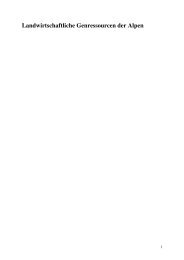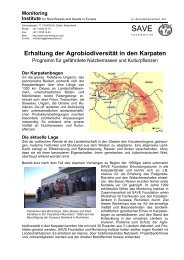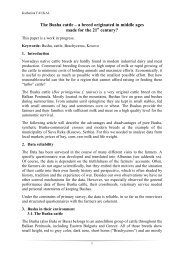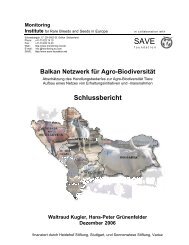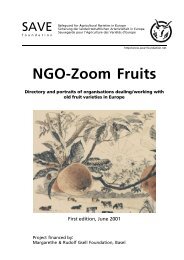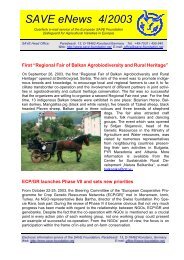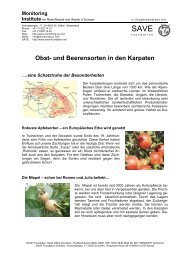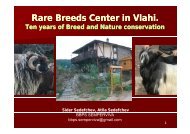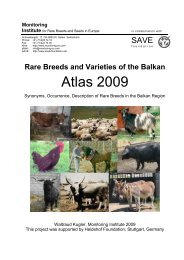Donkey Breeds in Europe - Safeguard for Agricultural Varieties in ...
Donkey Breeds in Europe - Safeguard for Agricultural Varieties in ...
Donkey Breeds in Europe - Safeguard for Agricultural Varieties in ...
Create successful ePaper yourself
Turn your PDF publications into a flip-book with our unique Google optimized e-Paper software.
animal <strong>in</strong> the villages. Mechanisation of agriculture led to nearly ext<strong>in</strong>ction of the<br />
asno de las Encartationes. Today they are still used as rem<strong>in</strong>iscence of the traditional<br />
image of the Basque small villages. This donkey breed plays an important<br />
role <strong>in</strong> the traditional basque agriculture and pastur<strong>in</strong>g. They are about 120 cm<br />
wither height.<br />
The color is brown and black sometimes dark<br />
strips on the legs, white signs around mouth<br />
and eyes. Belly is also white.<br />
S<strong>in</strong>ce 1996 Association ADEBUEN works<br />
(Association <strong>for</strong> the Defense of the <strong>Donkey</strong> of<br />
the Encartaciones) on conservation of the<br />
donkey. In the southwest of France, the “Ane<br />
des Pyrénées” (see page 25) is bred, which is<br />
very similar to the Asno de las Encartaciones.<br />
Stock : Total: ca 100<br />
Herdbook: no<br />
Risk Status: critical<br />
Conservationprogramme: yes<br />
Contact: Asociación de defensa del Asno de<br />
las Encartaciones (ADEBUEN); Euskal abereak San Miguel 11-1º; 48200 Garai;<br />
Prov<strong>in</strong>cia Bizkaia; Tel.: 946 79 80 02; Fax: 946 79 80 04; others:<br />
http://www.nekanet.net/razas/asno_c.htm<br />
Burro Majorero (syn: Canary Island; Common Spanish)<br />
The ancestors of the Burro Majorero orig<strong>in</strong>ally came from the North West of Africa.<br />
It is an autochthonous breed of the Canary Islands and these days is used <strong>in</strong> the<br />
tourist bus<strong>in</strong>ess. The Burro Majorero has a withers height of c. 1.10m and weighs<br />
100 to 150 kg. The coat colour is dark or light grey. This breed is particularly well<br />
adapted to the volcanic environment of the Canaries. There is no known conservation<br />
organisation. The stock numbers are <strong>in</strong> decl<strong>in</strong>e.<br />
Stock: Total (2005): less than 200 animals at Fuerteventura and a few purebred<br />
<strong>in</strong>dividuals at Lanzarote.<br />
Herdbook: unknown<br />
Risk Status: endangered<br />
Conservation programme: yes<br />
Contact: Asociación SOO Grupo para la Conservación y Fomento del Burro Majorero;<br />
Gambuesa, 30; 35600; Puerto del Rosario Fuerteventura; Tel.: 928 85 10 15<br />
Ase MallorquÍ (syn.: Asno Mallorqu<strong>in</strong>; Burro Mallorqu<strong>in</strong>;Malorqunia; Balear)<br />
The ma<strong>in</strong> geographical area of the donkey was the island of Mallorca but it did extend<br />
to almost all the other islands of the Balearic group. The mares were used <strong>for</strong><br />
reproduction and draught, carry<strong>in</strong>g sacks of olives at harvest time and as a means<br />
of transport <strong>for</strong> breeders. The stallion was dedicated to mule breed<strong>in</strong>g. A group of<br />
<strong>in</strong>terested breeders and owners founded an association (ACRIPROASMA) to promote<br />
the awareness of the breed. In 2002 it was recognised by the government.<br />
The association def<strong>in</strong>ed a standard, identified animals and set up a registration<br />
book.<br />
Description: its structural confirmation is similar to that of the Catalan donkey but it<br />
is shorter <strong>in</strong> height and f<strong>in</strong>er boned. Height at withers: 1,45m - 1,55m <strong>for</strong> sires and<br />
1,25 - 135m <strong>for</strong> mares. The coat is black to dark grape with shad<strong>in</strong>g of white to<br />
grey around the nostrils, under the mouth, eye and underbelly.<br />
46



